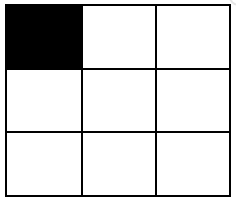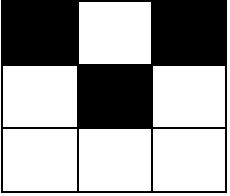Class Solution
- java.lang.Object
-
- g2701_2800.s2768_number_of_black_blocks.Solution
-
public class Solution extends Object
2768 - Number of Black Blocks.Medium
You are given two integers
mandnrepresenting the dimensions of a 0-indexedm x ngrid.You are also given a 0-indexed 2D integer matrix
coordinates, wherecoordinates[i] = [x, y]indicates that the cell with coordinates[x, y]is colored black. All cells in the grid that do not appear incoordinatesare white.A block is defined as a
2 x 2submatrix of the grid. More formally, a block with cell[x, y]as its top-left corner where0 <= x < m - 1and0 <= y < n - 1contains the coordinates[x, y],[x + 1, y],[x, y + 1], and[x + 1, y + 1].Return a 0-indexed integer array
arrof size5such thatarr[i]is the number of blocks that contains exactlyiblack cells.Example 1:
Input: m = 3, n = 3, coordinates = [[0,0]]
Output: [3,1,0,0,0]
Explanation: The grid looks like this:

There is only 1 block with one black cell, and it is the block starting with cell [0,0].
The other 3 blocks start with cells [0,1], [1,0] and [1,1]. They all have zero black cells.
Thus, we return [3,1,0,0,0].
Example 2:
Input: m = 3, n = 3, coordinates = [[0,0],[1,1],[0,2]]
Output: [0,2,2,0,0]
Explanation: The grid looks like this:

There are 2 blocks with two black cells (the ones starting with cell coordinates [0,0] and [0,1]).
The other 2 blocks have starting cell coordinates of [1,0] and [1,1]. They both have 1 black cell.
Therefore, we return [0,2,2,0,0].
Constraints:
2 <= m <= 1052 <= n <= 1050 <= coordinates.length <= 104coordinates[i].length == 20 <= coordinates[i][0] < m0 <= coordinates[i][1] < n- It is guaranteed that
coordinatescontains pairwise distinct coordinates.
-
-
Constructor Summary
Constructors Constructor Description Solution()
-
Method Summary
All Methods Instance Methods Concrete Methods Modifier and Type Method Description long[]countBlackBlocks(int m, int n, int[][] coordinates)
-